5.1 Soil
1/25
There's no tags or description
Looks like no tags are added yet.
Name | Mastery | Learn | Test | Matching | Spaced |
|---|
No study sessions yet.
26 Terms
Soil
a dynamic system within the larger ecosystem that has its own inputs, outputs, storages, and flows
Importance of Soil
Ultimately responsible for all the food we consume.
Provides all nutrients for producers
-Habitat for many organisms
Filters water
Recycling nutrients (home to many decomposers and detritivores) so that chemical cycles can occur
Services Soil Provides
carbon sequestration
water purification, reduce contaminants
climate regulation
nutrient cycling
pharmaceuticals and generic resources
habitat for organisms
flood regulation
foundation for infrastructure
constriction materials
cultural heritgate
Soil is made of
inorganic and organic components, water and air. 25% water, 25% air, 5% organic, 45% mineral.
Soil is made up of inorganic and organic components, creating a complex mixture pf interacting components
Inorganic components/mineral matter (rock fragments, sand, silt and clay) come from weathering of parental rock. Organic components include living organisms and material from the decay of organisms.
Components and Function
Rock particles (insoluble or soluble) = provide soil skeleton
Humus (decomposing plant/animal matter = gives soil the colour
Water (seeping down precipitation or moving up) = minerals available, leaching, saliantion, waterlogging
Air (oxygen or nitrate) = for respiration and plant growth
Organisms = breaks down organic matter, decompose, mix soil
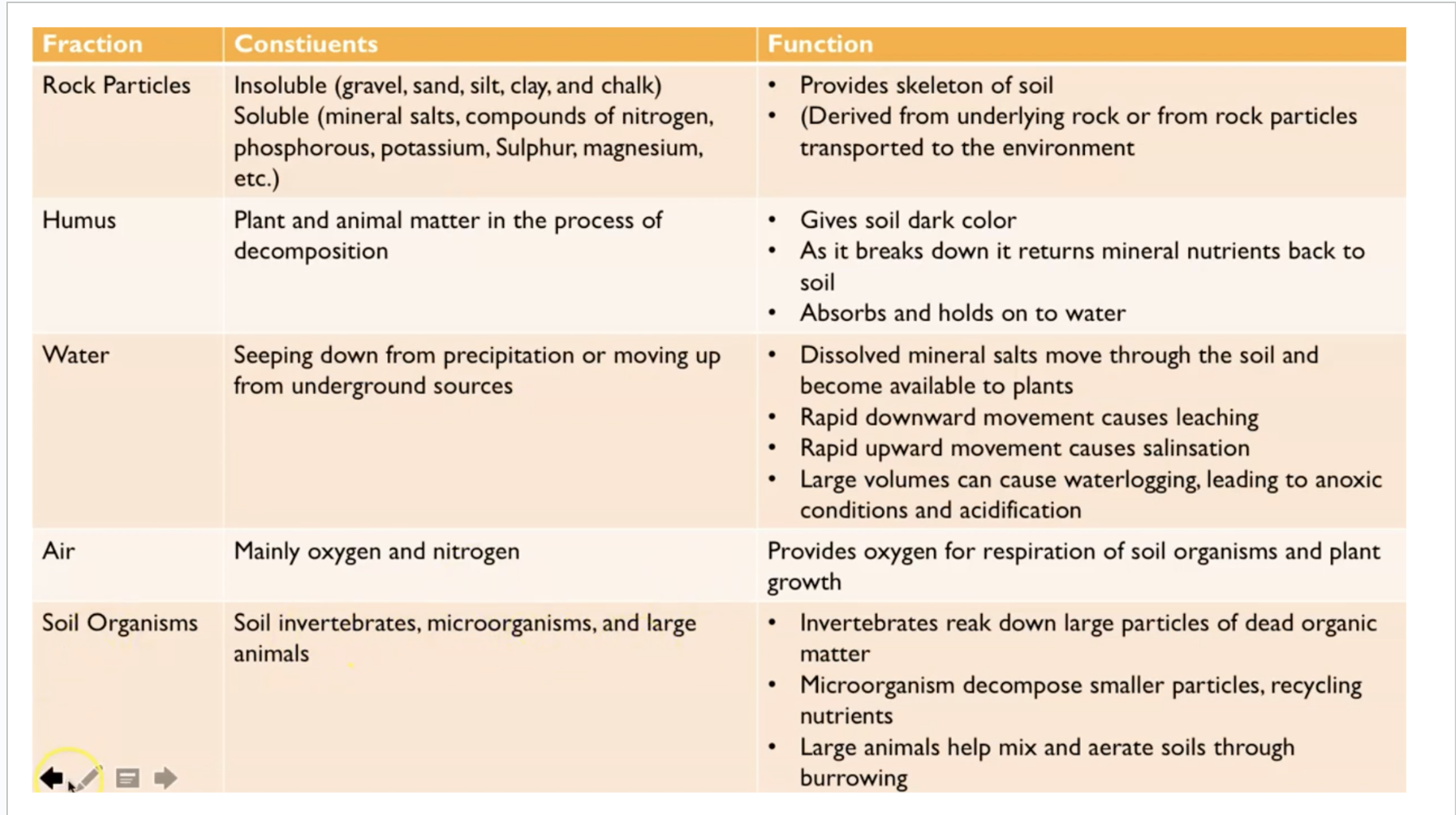
Soils develop a stable, layered structure known as a profile, made up of
several horizons, produced by interactions within the system over long periods of time, formed over 1000s of years through sucessions
Soil profile
made up of several horizons
Soil horizons
distinct layers in soils, show a transition from more organic components in the upper surface to inorganic below
Soil Horizons in different biomes
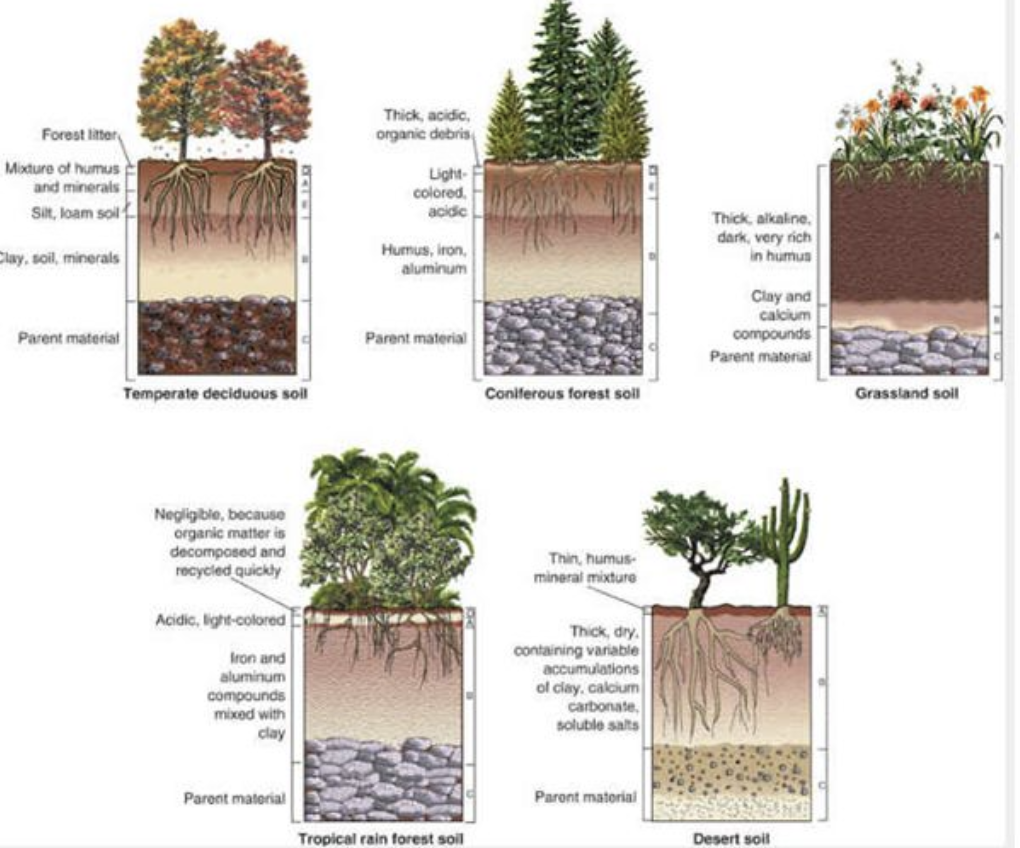
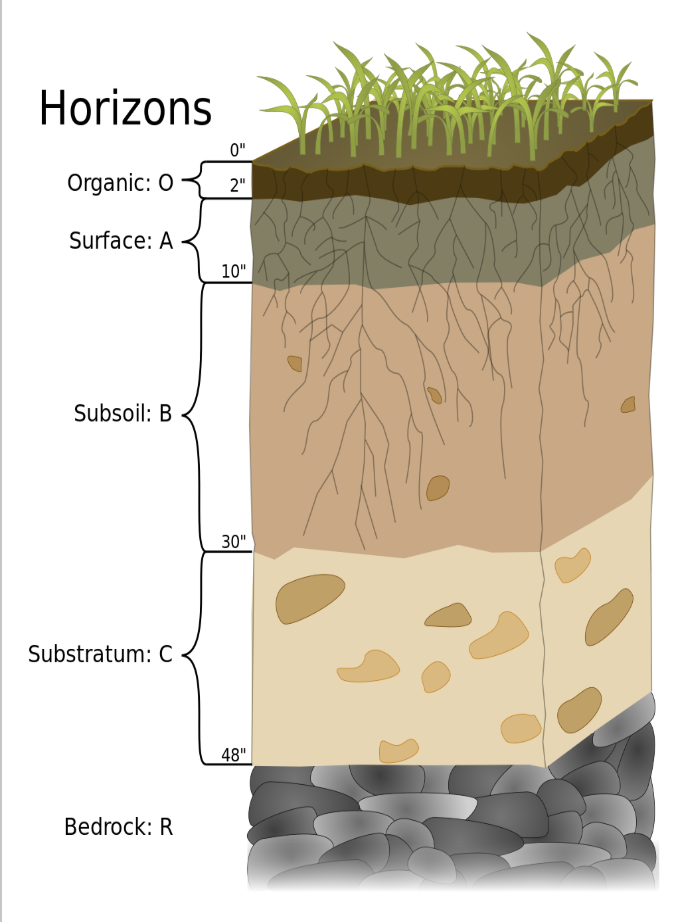
Soil Horizons (layers)
Top Layer (O Horizon): This is rich in organic matter like decomposing leaves and dead plants. It's often dark brown or black and is the thinnest layer, sometimes absent in some soils.
Topsoil (A Horizon): This is the most fertile layer, teeming with life. It's a mix of minerals from the parent rock below, along with decomposed organic material from the O horizon. This layer is crucial for plant growth.
Subsoil (B Horizon): This layer contains minerals that have been leached, or washed down, from the topsoil. It can be denser than the topsoil and may have a different colour due to the accumulation of specific minerals.
Parent Material (C Horizon): This layer is the underlying rock or unconsolidated material from which the soil formed. It's less affected by weathering and biological processes compared to the layers above.
Bedrock (R Horizon): This is the solid, unweathered rock beneath the soil profile.
Soil Formation
through weathering (breakdown of rock into smaller pieces, physical, biological, chemical), erosion ( removal of rock particles by wind, water, ice, or gravity) decomposition, and deposition
Soil Inputs
Dead organic matter inputs may include, but not be limited to, plant litter, dead animal biomass, manure.
Inorganic mineral inputs may include weathering, deposition or decomposition, precipitation (water with dissolved minerals), gases, air, humidity and solar energy.
In managed soil systems, many inputs are anthropogenic (compost, fertilizer, agrochemicals, irrigation, salinization)
Soil Outputs
losses of dead organic matter due to decomposition, losses of mineral components and loss of energy due to heat loss.
Water + Minerals = evaporation, absorbed by plants, plant uptake
Air + Gases = release gas as CO2 or O2, diffuse
Organisms = erosion, transport particles
Energy = transferred to biosphere when consumed, released as thermal energy
Transfers
Infiltration = water from precipitation or irrigation seeps from the surface into the soil.
Percolation = water movement in soil
Groundwater flow = water movement horizontally
Biological mixing = organisms mix soil
Aeration = movement of air in/out of soil
Erosion = water or wind transfer soil particles
Leaching = minerals washed out of soil
Transformation
Decomposition (organic → inorganic) = nutrient release, forms humus
Weathering (mineral breakdown) + rocks break down, form soil and nutrient release
Nutrient Cycling (chemical conversion) = change in nutrient form and availability
Salinisation (chemical accumulation) = salts accumulate in soil, affects chemistry
Soil System Diagram
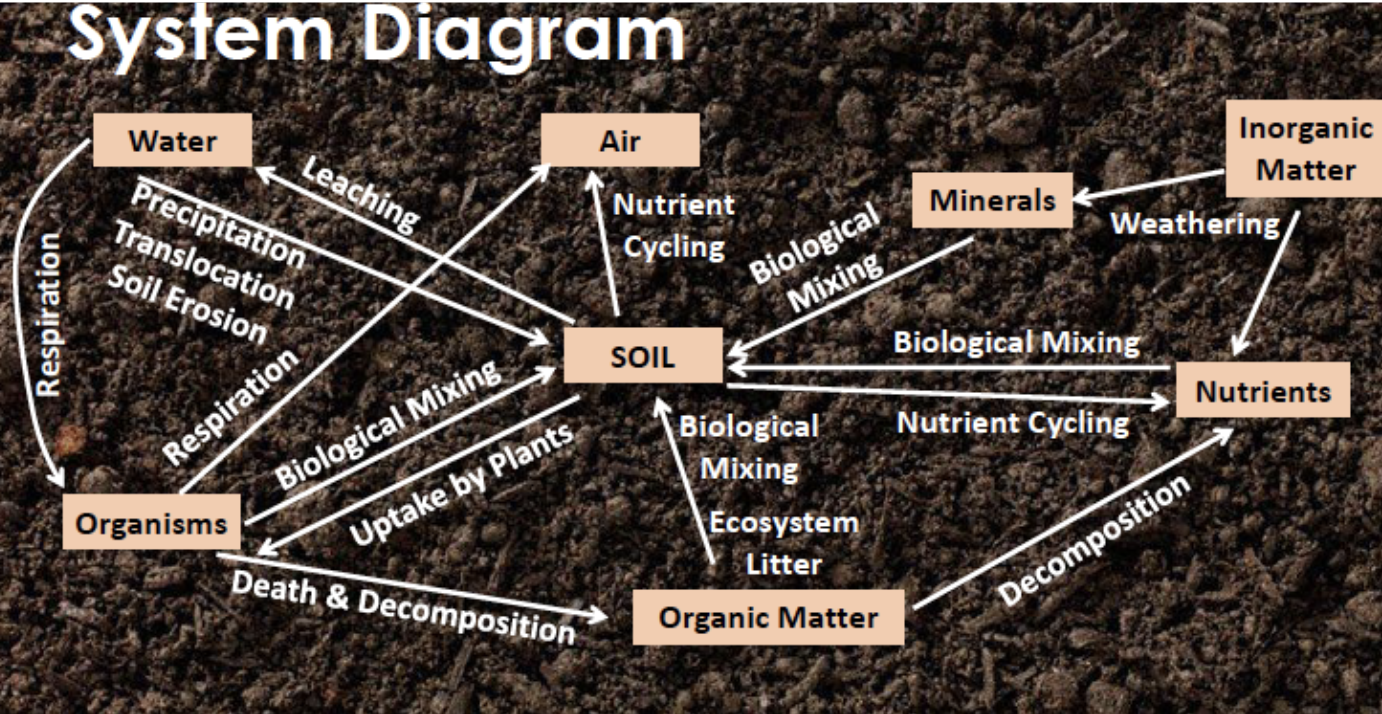
Soil systems are essential for the water, carbon and nitrogen cycles.

Soils provides
the foundation of terrestrial ecosystems as a medium for plant growth (a seedbank, a store of water and almost all essential plant nutrients).
Soils store the key nutrients for plants
Nitrogen (N), Phosphorus (P), and Potassium (K)
Soils contribute to biodiversity by providing a habitat and a niche for many species
Large biodiversity, including microorganism, animals and fungi
Soils have an important role in the recycling of elements as a part of biogeochemical cycles
The major input is of dead organic matter from the plants entering the soil. Leaf litter is then broken down by detritivores (eat dead organisms) into smaller fragments and decomposed by decomposers (break down organic matter)
Soil texture
the physical makeup of the mineral soil. It depends on the relative proportions of sand, silt, clay and humus
determined by the relative amount of the different types and sizes of mineral particles.
If fairly equal portion of each are present the soil is called loam.
Soil texture affects the fertility and primary productivity of an ecosystem.
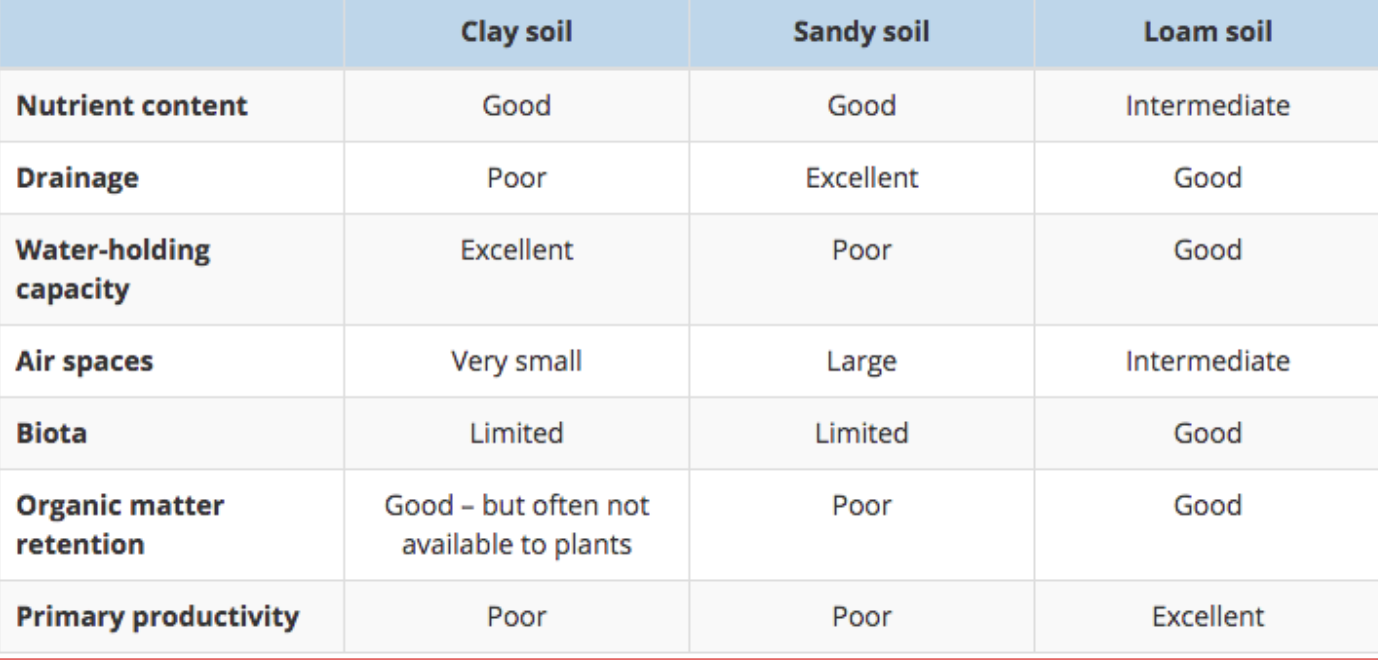
Soil texture affects primary productivity through the differing influences of sand, silt, clay and dead organic matter, including humus.
Humus contributes significantly to the texture of soils in which it is abundant.
It is a dark brown or black substance lying beneath the leaf litter.
t has a loose, crumbly texture formed by the partial decay of dead plant material.
Influences: mineral nutrient retention versus leaching, water retention versus drainage, aeration versus compaction or waterlogging, ALL influence primary productivity.
Soils can act as carbon sinks, stores or sources, depending on the relative rates of input of dead organic matter and decomposition
A carbon source releases more carbon than it absorbs
A carbon store/stock maintains a constant amount of carbon
A carbon sink is a reservoir that absorbs more carbon than it release